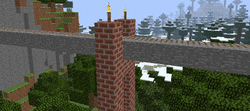TrainCarts
(Created page with "Los trenes pueden viajar sobre placas de presión además de escaleras de mano y también por debajo de los railes de cuesta arriba puestos en el tejado.") |
(Created page with "» Físicas") |
||
| Line 15: | Line 15: | ||
Los trenes pueden viajar sobre placas de presión además de escaleras de mano y también por debajo de los railes de cuesta arriba puestos en el tejado. | Los trenes pueden viajar sobre placas de presión además de escaleras de mano y también por debajo de los railes de cuesta arriba puestos en el tejado. | ||
[[Special:MyLanguage/TrainCarts/Physical|» Físicas]] | |||
[[Special:MyLanguage/TrainCarts/Physical|» | |||
<div lang="en" dir="ltr" class="mw-content-ltr"> | <div lang="en" dir="ltr" class="mw-content-ltr"> | ||
Revision as of 17:01, 24 April 2021

| |
| Minecarts redefined | |
| Spigot: | TrainCarts |
|---|---|
| GitHub: | TrainCarts |
TrainCarts es un plugin desarrollado por Bergerkiller e incluye todo relacionado con trenes de vagonetas. Inicialmente fue desarrollado para unir múltiples vagonetas juntas, creando un tren en movimiento. Con el paso del tiempo el plugin ha crecido hasta obtener muchas características, como señales, comandos, propiedades, adjunciones y una API flexible que otros plugins pueden implementar para añadir sus propias características.
Trenes
La primera cosa que notarás es que ya puedes conectar vagonetas juntas para formar trenes infinitamente largos. Cada vagoneta en este tren es llamado un "miembro", todos los miembros juntos se les denomina un "grupo". Cada miembro se comunica con el grupo, entonces si un la vagoneta frontal colisiona con un bloque, el grupo entero se frena. Cuando alguien empuja una vagoneta, la fuerza de empuje se reparte por todo los miembros, entonces los trenes largos responden más tarde que los trenes cortos.
Nuevas físicas
Los trenes pueden viajar sobre placas de presión además de escaleras de mano y también por debajo de los railes de cuesta arriba puestos en el tejado.
Signs
Loads of different signs are available to automate stations, eject trains, put players in trains or update train configuration.
Command
The plugin has lots of commands you can use to alter the behavior of trains and minecarts.
Train Spawn Chest
A special item allows for trains to be picked up and spawned.
Path finding
Trains can have a destination set, after which switcher signs will automatically switch the track to lead the train towards it with the shortest route possible. This can be used to automate a large train network, sending trains to different stations fully automatically. It is also possible to configure a list of destinations the train should visit and have the train automatically go from one destination to the next.
Configuration
TrainCarts can be configured in the config.yml file. All setting nodes have a header to help you understand what that particular node adjusts. Other than that, you can set the default train properties (properties applied to new trains) in the DefaultTrainProperties.yml file. The nodes should speak for themselves. Try not to touch the other files, as it can cause corrupted save data, or the plugin getting out of sync. Deleting the files should re-set TrainCarts completely, may one of the files get corrupted. The plugin automatically generates all configuration needed.
Attachments
» Attachments (WIP)
Permissions
Like in all plugins that use BKCommonLib as a base, all permissions can be found in PermissionDefaults.yml in the plugin folder. There they are all listed together with a description and permission default, which you can alter as well.
Performance
Some features by this plugin may result in server or client lag. There are ways to prevent them.
API and Add-ons
TrainCarts has a flexible API which allows other plugins to implement custom track, signs, attachments and more.
- TC-Coasters: Adds smooth rollercoaster track to TrainCarts
Useful Links
Depreciated Addons
(No longer supported in current versions of Traincarts)
ActionBlocks, added block-based systems to the game. They were dumbed-down versions of the sign systems mentioned above.